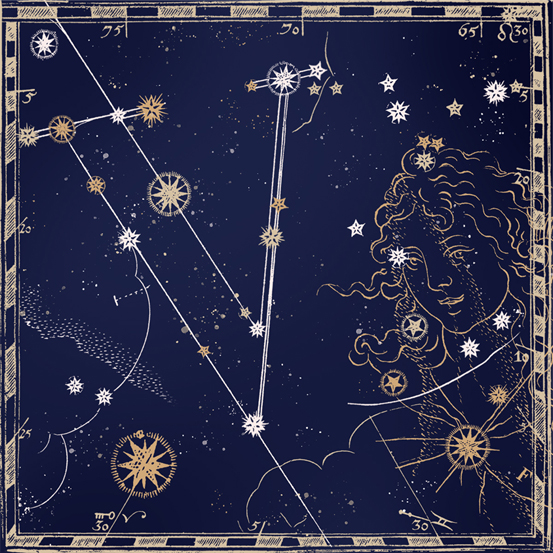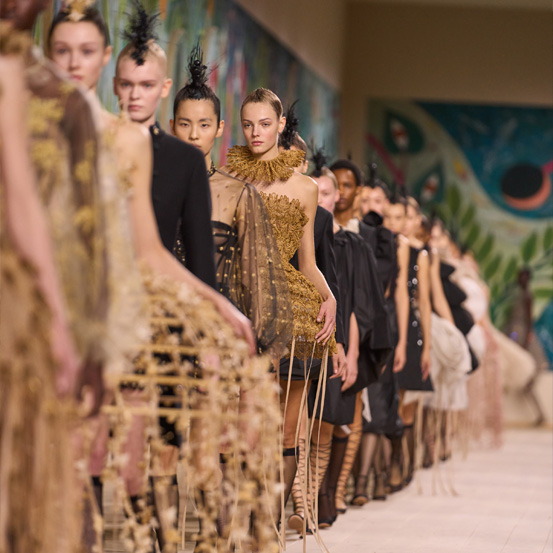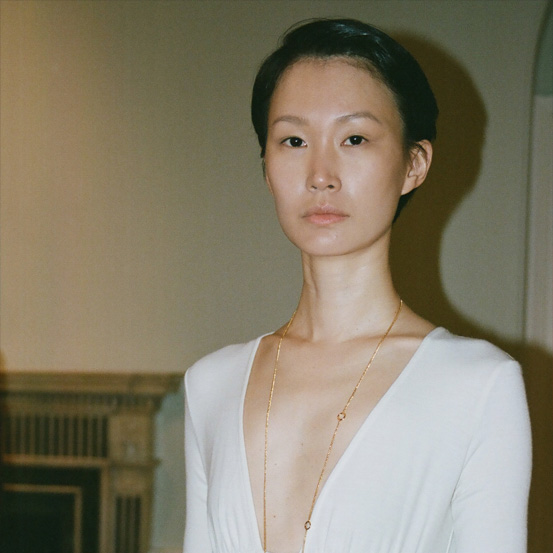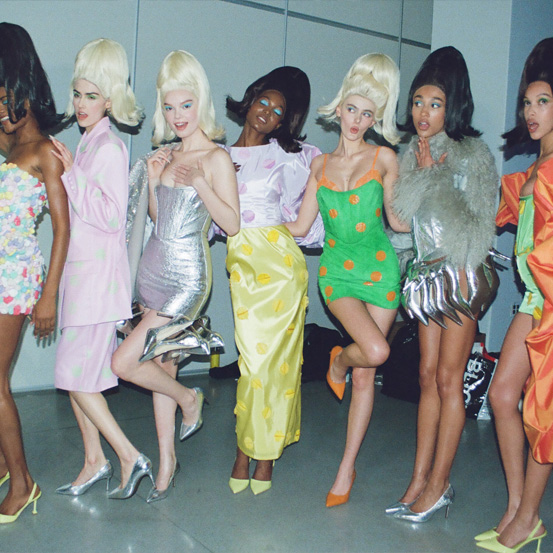It is said that the best solution to conquer fear is to face it. In the (not so uncommon) case of fear for the color white, the world of Fashion has done us a huge favor. From runways to red carpets, there is no escaping the impact of this color.
It is said that the best solution to conquer fear is to face it. In the (not so uncommon) case of fear for the color white, the world of Fashion has done us a huge favor. From runways to red carpets, there is no escaping the impact of this color.

Agoraphobia, arachnophobia, claustrophobia: there are an infinite number of phobias, but none is as common as leukophobia, the intense, irrational fear of the scariest color in the Fashion world, white. I’m ashamed to confess I am part of that majority. As soon as I see a piece of clothing in the hue, memories come to me. Visions of all the scoldings I had to face for getting my "good" shirt dirty, or snide comments, typical of Portuguese villages, of "how dare she wear that light dress to a wedding." The color has such a hold on me that I avoid it altogether apart from the rare white t-shirt. And even disregarding all my traumas, there is no denying it: wearing white is always a risk, and the potential for stains is overwhelming. I don’t just mean the most literal interpretation of the word, the typical coffee or grease splashes that have a magnetic attraction to the color, but also all the fashion faux pas associated with white clothing. There is an almost absurd amount of informal laws regarding wearing white: you shouldn't wear it in the cold season, you can't wear it to a wedding or a funeral, or with black shoes, etc. Even if we manage to abstract ourselves from all these canons, the color is difficult to pull off. It is almost impossible to think of a white dress without the virginal image of a bride coming to mind. But even in the face of all these drawbacks, a brief exploration of the recent collections of the titans of the industry (Valentino, Jacquemus, among others) indicates that Fashion is ready to overcome all these dilemmas. To understand the justification behind this movement we have to go back in time to observe some of the occasions when white has become synonymous with fashionable.
Let's start with the inevitable: wedding dresses. There is no way to approach the importance of this color in Fashion without mentioning moments like Princess Diana's wedding dress which, in the 1980s, had a cultural impact similar to that of the Renaissance in medieval Europe. Mere hours after the release of the wedding photos, replicas were already being produced for all the women who wanted to copy Lady Di. The balloon sleeves, the voluminous skirt, the bows, the ruffles, there is no better example to describe the sensibilities of the time so effectively. Grace Kelly's iconic wedding dress also captivated the whole world's attention and, unlike Diana's, continues to inspire brides to this day. Such is the case of another member of British royalty, Kate Middleton, who, for her wedding to Prince William, instructed Sarah Burton, the designer at the helm of Alexander McQueen, to be inspired by Kelly's dress.
Even though we can spend pages and pages considering all the magnificent wedding dresses that have influenced the history of Fashion, there are those that have the same authority precisely because they attack the sanctity of the garment. Of course, it takes courage to desecrate the altar of the wedding dress, but characters like Madonna have never been known for their modesty. It was through her boldness that the singer subverted all the innocence associated with the wedding dress. Upon receiving numerous criticisms for her hit Like a Virgin, which accused Madonna of promoting premarital sex, the artist decided to double down with her performance at the inaugural VMAs in 1984. Starting the performance atop a cake in a wedding dress, the singer kept dragging herself across the floor while simulating masturbation to the tune of the lyrics "Been saving it all for you." She was also the one who, in 1994, inspired her then-boyfriend, Dennis Rodman, to wear a wedding dress to the launch of his autobiography. Justifying the outfitthrough the pretext that he was marrying himself, Rodman's dress had a similar effect to Madonna's: it stirred the waters of public opinion.
Apart from its immense potential vis-à-vis the legacy of marriage, whether to honor or dishonor it, a white outfit is a double-edged sword. The resonance of the wedding dress is such that any look in this color, no matter how simple, is automatically qualified to become wearable at a wedding. This is one of the barometers by which we judge any outfit of the hue: how far it strays from association with holy matrimony. Over the decades we have found some dresses whose impact is so brilliant that it overshadows said comparisons. We would never think of dresses like Marilyn Monroe's in The Seven Year Itch(1955) as belonging to a bride. Or the white jumpsuits Farrah Fawcett wore to the historic Studio 54 as part of a religious rite. But no era separated white from marriage as much as the so-called naughties (the Y2K era as it is known today) who, through various red carpets, consummated this divorce. We are not referring to the terrifying ensembles of tunics and jeans that still haunt us, but to the elegant white dresses that some of the most influential celebrities of the era wore. From Angelina Jolie at the 2004 Oscars in a delicate white Marc Bouwer gown to supermodel Iman at the 2003 Met Gala in a Calvin Klein gown inspired by Billie Holiday, there are many examples of irreverent white looks that have gone down in history. However, perhaps no white dress was as impactful as the one Björk wore to the 2001 Oscars gala, where, in a true demonstration of camp, she chose a piece that perfectly mimicked the body of a swan, with her long neck used to adorn the Icelandic singer's neckline.
Today, celebrities like Rihanna continue to wear white as a statement of intent. In fact, some of her most iconic looks instrumentalize white. Think of her appearances at the Met Gala, an event synonymous with her influence on Fashion. In 2014, with the Charles James: Beyond Fashion theme in mind, the singer wore a white Stella McCartney coordinate, where her tattoos were highlighted by the simplicity of the color. In 2018, Rihanna chose the hue as the basis for an outfit that should not only be mentioned as one of the artist's best looks but also in the gala's history. With the help of the prodigy that is John Galliano, the singer sported a white gown, cape, and miter (the triangular hat worn by high members of the clergy, let's not be fooled by the colloquialism) adorned with thousands of crystals.
Rihanna is just one example of the level of wisdom we aim to achieve. The greatest in the Fashion world has never refrained from white, never let its so-called rules scare them away. In fact, in recent years the number of brands that have dedicated entire runways to color is enough to prove the absence of any modesty. Think of Jacquemus' Fall/Winter 2022 collection aptly entitled Le Papier, where, over 61 looks, the versatility of the tone was illustrated. Presented in a salt mine in the South of France, the collection was designed by Simon Porte Jacquemus, as a new beginning for the brand. Also, Pier Paolo Piccioli, creative director of Valentino, demonstrated the potential behind the hue. Known for his penchant for garish colors (think the wildly popular Pink PP), the Italian designer discarded the hues that are associated with his style for the Fall/Winter 2020 Haute Couture collection. In a monochromatic collection, Piccioli used white as a commentary on a world that, for many, was devoid of color due to the pandemic crisis. But no designer has demonstrated the potential of white like Alexander McQueen, who, in the Spring/Summer 1999 show entitled No. 13, used a white dress to create one of the most important moments, ever, in the history of Fashion. At the end of the show, Shalom Harlow, supermodel, and former ballerina, appears in a white dress, supported by a belt in the neckline area and, standing on a rotating platform in the center of the stage, begins to interact with two robotic arms that were on its periphery. At a certain point, these robots go on the attack, shooting yellow and black paint at Harlow, in a delightful fusion of performance and Fashion. Faced with the jets of color shot at the model, coffee stains are no longer a concern. After all, if McQueen understands white clothing as a blank canvas, why can't we do the same? We don't have to be afraid of the stains, we just have to artfully orient them to create the illusion of intention.
Translated from the original on Vogue Portugal's The Innocence Issue, published February 2023.Full story and credits on the print issue.
Most popular

.jpg)
“Chamo-lhe campo de férias”: como é realmente ser um VIC (“Very Important Client”) na Semana de Alta-Costura de Paris
05 Feb 2025

Relacionados



.jpg)

